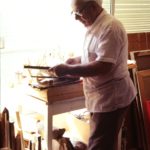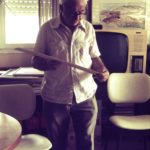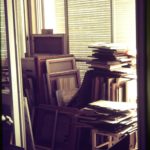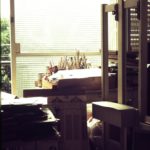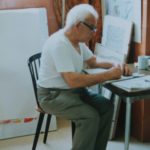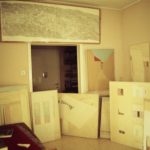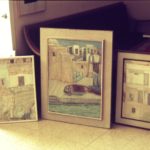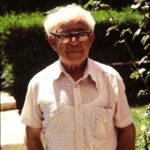Yehoshua Grossbard painted walls from a very young age. He continued doing so to his last days.
Born to a large family in Serock, Poland in 1900, his father made his living as a house painter/decorator. After a few years of basic education, Yehoshua was a young teenager, just 12 or so, when he joined his father to help him make a living. His family, living in poverty in a small house was at the same time filled with music, poetry and art.
In his working life, Yehoshua was renowned as a master painter/decorator, practicing such specialties as tromp l’oeil (fake three dimensional images on walls, using color shadings), cutting stencils to create patterns with contrasting colors (many years later he reinvigorated the traditional Jewish art of paper cuts and published two books and lectured extensively), and painting imitation wood panels in oils. Not many decorators could do that even then. These are lost arts now.
He realized his interest in art at an early age and started studying with various art teachers, and went on trips to paint landscapes. His paintings then were influenced by the dark palette of Northern European light.
A sociable, gregarious and charming man. In Poland he was involved in theater – acting in various roles, book readings, poetry and Jewish culture. he was also politically active in left wing Jewish organizations in Poland. At the age of 28 he met Batia Friedkes, who became his partner in life and also in art. This website is dedicated to both.
Yehoshua escaped Poland in 1939, on one of the last trains to leave for Romania, and from there came
to Palestine on an illegal refugee ship, swimming ashore with a bundle of paintings
then hiding, until an amnesty was awarded. Apart from a brother and two sisters who survived, the
entire family perished in the holocaust – murdered by the Nazis. His brother and a sister were already
married with children – all perished. He never spoke of their death, only of what they were like when
living.
It took some years for Yehoshua to adjust to the shock of bright Mediterranean light. His whole palette changed, as light pinks, yellows and greens of Arab houses populated his painting, resting the eye – as he said – from the painful glare of the bright sun.
Yehoshua and his family lived on the divide between the Jewish and Arab section of Haifa, a port city in Northern Israel. He had his easel on the balcony overlooking the port, Haifa bay and stacked hillside houses of downtown Haifa.
Later in life, his palette grew even lighter, his paintings suffused with white and light yellows and blues. Structures more abstract in appearance, yet still related to the landscape.
In 1955 he went to study in Paris at the Academie de la Grande Chaumiere. staying there for a few months. Painting many of Parisian rooftops.
Yehoshua is an urban landscape painter. His paintings are of buildings, stacked on top of each other, but rarely include the human figure – yet are full of human stories as they are obviously there in the curtained windows of those houses, hinting at us with the washing hanging on balconies. His flat painting structure reduced perspective to shapes, rather than spaces.
In Palestine, later to become Israel, he was deeply involved in politics of the left, human and workers’
rights. Rights of Jews and Arabs. He was a member of MAKI, the Israel Communist Party.
He was especially involved in the Art’s Community. In early1950’s, with a number of artists such as Marcel Janco, Itche Mambush, and others, they scouted a deserted village in the hills South of Haifa, called Ein Hod (fountain of beauty), and proposed to the Interior Ministry to turn it to an artists’ colony, where membership is limited to painters, sculptors, musicians, etc. The village was approved and thrives – with galleries, workshops, exhibitions. He served on the village committees for many years, involved in selection panels for exhibitions, etc. Ein Hod today is world famous as a successful artist’s colony.
Yehoshua was active also in the Israeli Artists’ and Sculptors’ Union, an association for the promotion of the arts, and played a part in the establishment of the Haifa Artists’ Gallery in 1954, named after Marc Chagall who attended its opening. He sat on juries organizing exhibitions, etc.
Despite the pressures of work, he was committed to paintings at every spare moment and produced a large body of work in oil paint. The list below is of the many one-man and group exhibitions he participated in, and the galleries that represented him for many years.
All his life he admired traditional Jewish folk art, in particular, the decorative friezes in synagogues, which were painted using stencils. He revived this traditional art which was used also for holiday decorations. After publishing two books of paper cuts, he spent many years in association with the Department of Education lecturing and teaching paper cut history and techniques to both school children and adults.
With his partner’s, Batia, declining health, they moved to a nursing home in Pardes Hanna, where he continued painting large oils and making papercuts to his last days.
Yehoshua passed away in 1992, aged 92.
